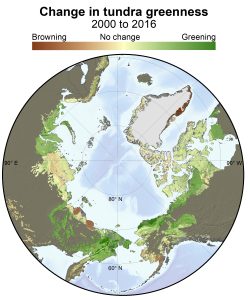
A new study shows much of the Arctic tundra biome became greener during recent decades, likely due to rising summer air temperatures stimulating plant growth. Ecoinformatics researchers from SICCS teamed with field ecologists at eight institutions around the world to investigate how, where, and why tundra greenness changed since the 1980s. Drawing on Landsat satellite observations from 1985 to 2016, they found tundra greenness increased at 38% of sampling sites across Alaska, Canada, and western Eurasia. Tundra greenness tended to increase in areas that warmed and represents plants colonizing previously barren areas, as well as existing plant communities growing taller, leafier, and often shrubbier. Conversely, tundra greenness decreased at only 3% of sampling sites during this period. Widespread increase in tundra plant growth can impact wildlife habitat and how people in northern communities use local ecosystems. This study is the first to evaluate pan-Arctic changes in tundra greenness using the Landsat satellites, which have much finer spatial resolution than measurements used in prior assessments. The study was led by Logan Berner (Assistant Research Professor) and is part of a larger project run by Scott Goetz (Professor) that is supported by NASA’s Arctic Boreal Vulnerability Experiment (ABoVE). The study also included Patrick Jantz (Assistant Research Professor), Richard Massey (Postdoctoral Researcher), and Pat Burns (Research Specialist) in SICCS. Read More.